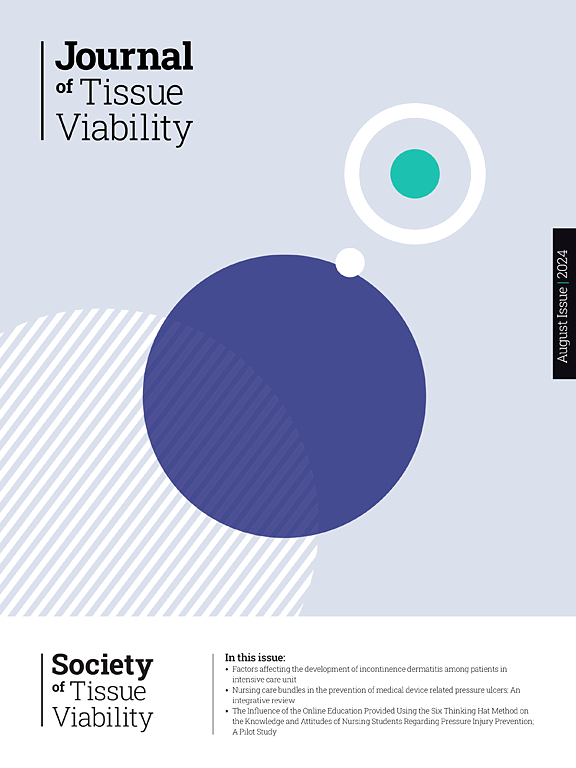Impact on management performance outcomes of standardizing wound care using integrated care bundles – results of a retrospective analysis
IF 2.4
3区 医学
Q2 DERMATOLOGY
引用次数: 0
Abstract
Aim
Integrated care bundles (ICBs) are interventions that used together synergistically improve care outcomes through standardized care pathways and can help to optimize healthcare expenditure. For wound care, ICBs may need to incorporate low or non-adherent dressings for patients with fragile and/or sensitive skin to help reduce the risk of damage. This retrospective analysis of real-world data assessed the impact on wound management outcomes of an ICB where a specific non-adhesive foam dressing was selected for patients with fragile skin and appropriate wound types.
Method
A comprehensive wound care program using ICBs was implemented and tracked using a real-time electronic database at two large healthcare organizations in Ontario, Canada (December 2015 to March 2018). Anonymized patient data were analyzed retrospectively.
Results
4421 patients with chronic wounds received an ICB including a non-adhesive foam dressing; 2242 patients did not receive an ICB. With use of the ICB including a non-adhesive foam dressing versus no ICB: mean Bates-Jensen Wound Assessment Tool (BWAT) Score was lower (27.4 vs 33.2); mean time to healing was shorter (12.7 vs 25.5 weeks) and mean time between dressing changes was longer (3.1 vs 1.9 days). Mean labor costs were lower with use of the ICB including a non-adhesive foam dressing (CAD 1766 vs 6488; p < 0.05). No adverse events related to the non-adhesive foam dressing were reported and the overall safety profile improved with use of the ICB.
Conclusion
Implementing ICBs can help to improve wound management outcomes and reduce labor costs compared with non-standardized care without an ICB.
使用综合护理包标准化伤口护理对管理绩效结果的影响-回顾性分析结果
目的综合护理包(ICBs)是通过标准化护理途径协同使用的干预措施,可以改善护理结果,并有助于优化医疗保健支出。对于伤口护理,对于脆弱和/或敏感皮肤的患者,ICBs可能需要结合低粘连或非粘连敷料,以帮助降低损伤的风险。对真实世界数据的回顾性分析评估了ICB对伤口管理结果的影响,其中为皮肤脆弱和适当伤口类型的患者选择了特定的非粘性泡沫敷料。方法在加拿大安大略省的两家大型医疗机构(2015年12月至2018年3月)实施了一项使用ICBs的综合伤口护理计划,并使用实时电子数据库进行跟踪。回顾性分析匿名患者资料。结果4421例慢性创面患者接受了含非粘性泡沫敷料的ICB;2242例患者未接受ICB。与不使用ICB相比,使用ICB包括非粘性泡沫敷料:平均Bates-Jensen伤口评估工具(BWAT)评分较低(27.4比33.2);平均愈合时间较短(12.7周vs 25.5周),平均换药间隔时间较长(3.1天vs 1.9天)。使用ICB(包括非粘性泡沫敷料)的平均人工成本较低(CAD 1766 vs 6488;p & lt;0.05)。无不良事件相关的非粘性泡沫敷料报告,整体安全性提高与使用ICB。结论与未实施ICB的非标准化护理相比,实施ICB有助于改善伤口管理结果,降低人工成本。
本文章由计算机程序翻译,如有差异,请以英文原文为准。
求助全文
约1分钟内获得全文
求助全文
来源期刊

Journal of tissue viability
DERMATOLOGY-NURSING
CiteScore
3.80
自引率
16.00%
发文量
110
审稿时长
>12 weeks
期刊介绍:
The Journal of Tissue Viability is the official publication of the Tissue Viability Society and is a quarterly journal concerned with all aspects of the occurrence and treatment of wounds, ulcers and pressure sores including patient care, pain, nutrition, wound healing, research, prevention, mobility, social problems and management.
The Journal particularly encourages papers covering skin and skin wounds but will consider articles that discuss injury in any tissue. Articles that stress the multi-professional nature of tissue viability are especially welcome. We seek to encourage new authors as well as well-established contributors to the field - one aim of the journal is to enable all participants in tissue viability to share information with colleagues.
 求助内容:
求助内容: 应助结果提醒方式:
应助结果提醒方式:


